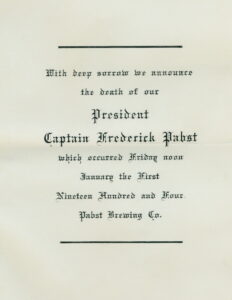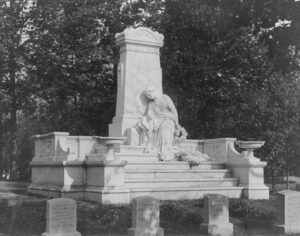Frederick Pabst worked his way up from being a poor German immigrant to ship captain, but his influence expanded far beyond the waters of Lake Michigan. From his birth in Prussia in 1836 to his death in 1904, Pabst was a giant of Milwaukee culture and history, and his influence cannot be erased from the city despite his departure from life.
On New Year’s Day 1904, Pabst died after a long struggle with multiple health issues, but it was two strokes that struck the final blow on the captain. He spent his last ten days of life at home, and after a sudden death, his family, friends, and even business partners came to mourn. The New York Times wrote that “Pabst was one of the most conspicuous citizens of Milwaukee, in whose development from a village to one of the great cities of the continent he was a large factor.” The funeral itself was held at the Pabst Mansion, meant to be a small group, but the city would not accept that. Mourners came to the mansion in such large crowds it didn’t matter if they were let in or not: The city had lost a leader.

Captain Pabst’s death announcement, 1904
The New York Times knew it too, as after listing Pabst’s great accomplishments, including being the president of the Wisconsin National Bank and a member of the Milwaukee, Calumet, and Deutcher clubs, the paper also notes that “the city abounds in monuments to (Pabst’s) enterprise… the Pabst skyscraper office building, the Pabst Theatre, and the Pabst Hotel.” But the paper neglected to mention one of the most beautiful and lasting testaments to Pabst’s legacy.
While the iconic Pabst Mansion on Wisconsin Avenue is a prime example of Flemish architecture, another lasting image of Pabst’s grandeur is located in Milwaukee: His family memorial. Forest Home Cemetery is home to many famous Milwaukeeans, including General Billy Mitchell, Jacob Best, Byron Kilbourn, and multiple Milwaukee mayors. But Pabst’s memorial is a classic piece of the Victorian “garden cemetery” movement, which sought to give more value to nature and art in cemeteries rather than just stating the name and death date of the deceased. Forest Home Cemetery is a prime example of this, at the time, new movement, with plenty of trees and elaborate monuments.

Pabst/Schandein grave monument at Forest Home Cemetery
Although the Pabst monument is only one of many in the cemetery, and not necessarily the largest, the tribute is fitting for this giant of Cream City history. Made of white marble, a small stage-type platform rises behind the Pabst family graves. In the center is a weeping woman, often known in Victorian cemetery lingo as “weepers.” These women represent sorrow and mourning, standing at the graves of the dead and crying for eternity. The woman at the Pabst monument wears a toga, more reminiscent of ancient Greece or Rome than Milwaukee in 1904. This gives the sculpture a sort of timelessness that shows that the loss of Pabst is more than just something this generation of Milwaukeeans will grieve, but a historic moment in world history.
By Nora McCaughey

